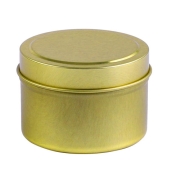How to achieve a smooth surface on gold candle tins?
Gold candle tins are popular for candle wholesalers and manufacturers due to their luxurious appearance and durability. They serve as functional containers and are essential to the product’s aesthetic. The smooth surface of gold candle tins enhances their visual appeal, making them more attractive to consumers. However, achieving such a surface requires careful attention to detail throughout the manufacturing process, from material selection to finishing techniques; each step plays a vital role in ensuring that the final product meets the highest quality standards. This article will share the factors that can help you achieve a smooth surface on gold candle tins.
Material Selection for Gold Candle Tins
You must select a suitable material for a smooth gold candle tin surface. The quality of the metal that the tin is made of plays an essential role in the final product. High-quality tinplate, a steel sheet coated with a thin layer of tin, is the material of choice for gold candle tins in Tsing. Tinplate is chosen for its durability, flexibility, and corrosion resistance. In addition to tinplate, the quality of the gold coating on the jar is also crucial. A high-quality, uniform coating ensures the gold-plated surface is smooth and consistent, without streaks, spots, or uneven areas.
Manufacturing processes for smooth gold candle tins
The next step is the manufacturing process once the suitable material has been chosen. How the gold candle tin is formed, finished and treated throughout production can significantly affect the final surface quality. One of the critical processes in manufacturing gold candle tins is stamping. Stamping is cutting and shaping the tinplate into the desired shape using a die. This process is carefully controlled to prevent surface defects such as scratches, dents or creases. After stamping, the tins undergo a series of finishing processes to improve their surface quality.
One of these processes is deburring. Deburring not only improves the safety of the tin but also removes rough edges that may cause defects in subsequent steps, resulting in a smoother surface. Another necessary finishing process is polishing. This process helps to eliminate any minor surface defects that may have occurred during the stamping or deburring process. It also prepares the jar for the gold coating.
Applying a perfect layer of gold
The gold coating gives them a luxurious and eye-catching appearance. However, achieving a perfect gold finish requires choosing the suitable coating material and carefully controlling the coating process to ensure a smooth and even coating.
One of the most common methods is electroplating, where a thin layer of gold is deposited onto the surface of the tin using an electric current. This method allows for precise control of the thickness and uniformity of the coating, resulting in a smooth and consistent finish. Another gold coating method is powder coating, where a fine powder of gold pigment is sprayed onto the tin and then cured under heat to form a smooth, durable coating. This method is particularly effective for achieving a uniform coating with high adhesion, and the key to achieving a smooth finish with powder coating is to ensure that the powder is evenly applied and that the tin is cured correctly to prevent any imperfections in the coating.
Improving Smoothness through Finishing Techniques
In addition to some of the abovementioned methods, Tsing also uses finishing techniques to improve the smoothness of gold candle jars. This technique is applied after the jar has been formed and coated to refine the surface, eliminate imperfections, and achieve the desired higher level of smoothness and gloss. One of the most effective polishing techniques is buffing. This uses a rotating wheel and a soft cloth or abrasive to polish the jar’s surface. This process helps remove minor scratches, blemishes, or surface irregularities, giving the gold candle jars a smoother mirror finish. Of course, in addition to finishing techniques, applying a protective clear coat can further enhance smoothness and durability. This seals the surface against scratches, rust, and environmental damage.
Importance of Quality Control
Even minor imperfections can compromise the appearance and durability of the final product without strict quality control measures to achieve a smooth surface. During manufacturing, Tsing conducts regular inspections at each stage to ensure that the tins are produced to the required specifications. For example, our inspectors check for any signs of surface defects such as scratches, dents or warping during stamping. Similarly, after polishing, the tins are inspected to ensure that the surface is smooth and free of any imperfections.
In addition to visual inspections, advanced testing methods are used to evaluate the quality of the gold plating. For example, adhesion testing can be done to ensure that the coating is adequately bonded to the tin surface. Thickness measurements can be taken to verify that the layer is uniform across the entire surface. Also, it is important to note that even after the jar coating is complete, it must be handled with care.
Achieving a Smooth Surface on Gold Candle Tins
In summary, achieving a smooth surface on gold candle tins requires a comprehensive approach, including material selection, manufacturing process, coating application, and quality control. Each factor ensures that the final product meets the highest quality and visual appeal standards. At Tsing, we are committed to providing our customers with gold candle tins that meet the highest standards of quality and artistry. So that candle wholesalers and manufacturers can obtain gold candle tins with a smooth surface.

-800x423.jpg)
-1030x644.jpg)
-1030x687.jpg)
-1030x644.jpg)
.jpg)

 Facebook
Facebook Twitter
Twitter Linkedin
Linkedin-80x80.jpg)
